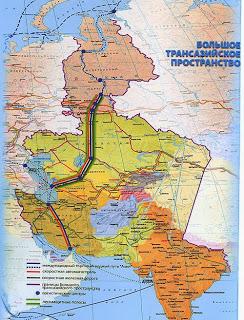 The decision to create a Eurasian Union on the basis of the Customs Union launched by Belarus, Kazakhstan and Russiaon January 1, 2013, might be one day regarded as one of the major geopolitical events of the XXI Century. The three former Soviet republics account together for almost one tenth of the world’s proven oil reserves, one fifth of the global wheat exports and one third of the world’s proven gas reserves, while the expected adhesions of Armenia, Kyrgyzstan and Tajikistan will turn the existing union into a truly Eurasian trade bloc.
The decision to create a Eurasian Union on the basis of the Customs Union launched by Belarus, Kazakhstan and Russiaon January 1, 2013, might be one day regarded as one of the major geopolitical events of the XXI Century. The three former Soviet republics account together for almost one tenth of the world’s proven oil reserves, one fifth of the global wheat exports and one third of the world’s proven gas reserves, while the expected adhesions of Armenia, Kyrgyzstan and Tajikistan will turn the existing union into a truly Eurasian trade bloc. Nevertheless, from a purely economic point of view, neither the Customs Union nor the planned Eurasian Union represent a real challenge for the United States and the other major economies. Together, Russia, Kazakhstan and Belarus produce just 4% of the global GDP, a figure that would only slightly change even in case of an eventual Ukrainian adhesion to the Union, currently discussed in Kiev. As a result, the process started by Minsk, Astana and Moscow may lead to the creation of a new pole able to successfully compete in the global economy only if post-Soviet integration will be in the framework of a greater Eurasian integration.
One of the means through which the Eurasian Union, to be established by 2015 by the members of the Customs Union, may achieve greater geo-economic significance is the creation of a network of infrastructures between Central Eurasia and the Southern periphery of the continent, that is between what geopolitics knows as Heartlandand Rimland respectively. In this regards, the most geopolitically important achievement would undoubtedly be the construction of the Trans-Asian Corridor of Development, a Russian project for a super canal connecting the Kara Sea and the Persian Gulf that was presented in Tashkent during an international conference on innovative ideas in November 2008. THE TRANS-ASIAN CORRIDOR OF DEVELOPMENT
 Envisaged by Damir Ryskulov, academician of the International Academy of Information and advisor to the Directorate of Analysis of the Moscow mayoralty, the Trans-Asian Corridor of Development is a major artery consisting of a canal, highway and railroad from Salekhard, on the Yamal Peninsula, to the Caspian Sea and on to the port of Bandar Abbas, on the Strait of Hormuz. If realized, this work would be the largest construction project in the history of mankind, as it would pass through Russia, Kazakhstan, Uzbekistan, Turkmenistan and Iran, leading to a dramatic improvement of the trade between Eastern Europe and Southern Asia.
Envisaged by Damir Ryskulov, academician of the International Academy of Information and advisor to the Directorate of Analysis of the Moscow mayoralty, the Trans-Asian Corridor of Development is a major artery consisting of a canal, highway and railroad from Salekhard, on the Yamal Peninsula, to the Caspian Sea and on to the port of Bandar Abbas, on the Strait of Hormuz. If realized, this work would be the largest construction project in the history of mankind, as it would pass through Russia, Kazakhstan, Uzbekistan, Turkmenistan and Iran, leading to a dramatic improvement of the trade between Eastern Europe and Southern Asia.According to Ryskulov, the Russian Urals region contains nearly one third of all surveyed reserves of mineral fuel and practically all Russian gas, but the freight traffic between Russia and the Asian countries follows some winding and therefore not particularly cheap routes. Hence the need of constructing a 6,600 kilometers super canal from the cold Kara Sea to the warm Arabian Sea, together with a highway from Salekhard to Kurgan, Arkalyk, Kzyl-Orda (with a branch off to Afghanistan via Kabul or Chakhabar and on to Pakistan), Dashoguz (with a branch leading to Sarakhs and on to the Persian Gulf via Iran) and Türkmenbaşy, and a railroad from Salekhard to Dashoguz, passing through Kurgan, Arkalyk and Kzyl-Orda, with a branch off to Serakhs and another to Türkmenbaşy.
The total cost for the realization of the project may amount to $100-150 billion, while the construction would take 15 years. Despite the almost complete lack of media attention to the project at the time when it was presented, the successes of Eurasian integration and Russia’s increasing interest in the Middle East might soon lead to the Trans-Asian Corridor of Development taking center stage. Only then, perhaps, the centuries-old ambitions of the Russian rulers to provide their country with an access to the warm seas will have a real chance to become a reality, and “Eurasia” will become synonym of a geo-economically integrated space stretching from the North Pole to the Indian Ocean.

